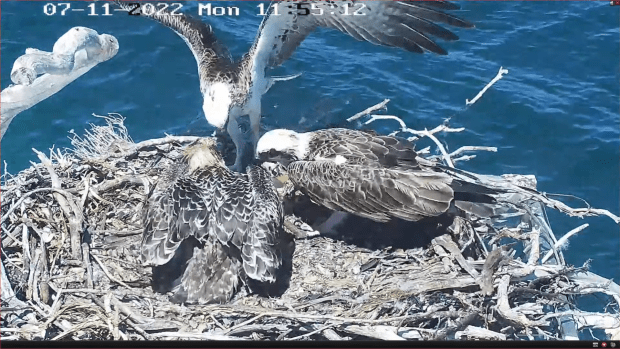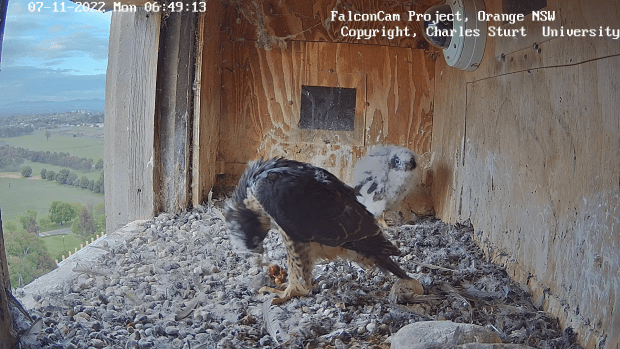12 December 2022
Good Morning Everyone,
Oh, I sure could use some blue skies right now. It is grey…everything is grey and brown. The temperature is hovering right at 0 degrees C. Even the birds are damp to the core. I will have to remember the beautiful blue sky of Grenada, those gorgeous hibiscus, and the birds filling the air with song. Thankfully all of the garden animals are doing well and happy to have me back along with the kittens. The Starlings are still here. There are 31. A host of House Sparrows and a Robin somewhere. The squirrels are here and Dyson was enjoying one of the new hard seed cylinders the last I checked this afternoon. The Crows are about and one Blue Jay has been for a visit. Life is good. I have no complaints save that it would be so nice to see some sun. On the Canadian prairies, that means it is cold. So bring it on! The cold and blue skies.
In the Mailbox: A question came in from ‘V’ wondering if there was a reason I was not mentioning Superbeaks.
This is a great question and I wanted to share it with everyone!
I briefly mentioned Superbeaks when the nest in Central Florida came on line, when there were eggs, and the hatches including the second one in my blog this morning, 11 December. It is not a nest that I consistently follow. Indeed, there are far too many nests to follow. It looks like there is good fishing around for Dad, Pepe. He brought a huge fish to the nest this morning.

I am an Osprey and hawk/falcon person. That said between the end of the UK Osprey season and the beginning again in spring, I watch other nests including the Bald Eagles in the US. There are ‘good’ Bald Eagle nests and some whose track record is not so good. There are nests where help is sought and others where it is thwarted, even if the on going potential tragedy is human caused. I know nothing about the Superbeaks nest but, will quietly watch them this year and see.
I highly recommend for Bald Eagles: the steady as you go team of Harriet and M15 at SWFlorida. They raise competitive eaglets so you just have to hold your breath at the early bopping but, normally, the eaglets grow up to be feisty besties. The relationship between M15 and Harriet is worth watching on its own.


Liberty and Guardian at the Redding Nest are fantastic. With the Redding Nest, you get commentary and videos by Gary and here is the chart for dates at the Redding nest that has been posted recently by Gary.

The Channel Islands nests of Thunder and Akecheta (West End), Chase and Cholyn (Two Harbours) and Andor and Cruz (Fraser Point) are excellent. Glacier Gardens comes on later. They are in Juneau. Alaska. How about Martin and Rosa at Dullas-Fairway? Clive and Connie at Captiva have 2 eggs.
Rolling the two eggs at Captiva. There is no confirmation yet of when they were laid.

Fingers crossed for a good season after rodenticide deaths in 2020, no eaglets last year, and the hurricane this year. There are others such as US Steel, the nests in Decorah but last year, they were hit with Avian Flu like Hilton Head. The National Arboretum Nest of Mr President and Lotus, both of the nests in the Kisatchie National Forest, E1 and E3, as well as the Metro Aviation Bald Eagle nest in Louisiana, Berry College with Pa Berry and Missey – the list is long!
Pa Berry and Missy working on their nest in Georgia.

There is no reason to believe that Avian Flu will not rear its ugly head this year also. We must remember that. It will impact birds eating birds or carrior (dead animals).
There are far too many nests to follow and everyone has their favourites. If you have recommendations – or nests not to watch recommendations – send me a comment. I would love to hear from you.
One of my favourites is Jackie and Shadow at Big Bear. They have had some problems in the past but we are always cheering them on and last year the amazing Spirit kept our hearts glowing.
The snow is really coming down at the nest of Jackie and Shadow in Big Bear Valley!


It is now Sunday afternoon and V2, the suitor trying to charm Gabby with the smokey head, has not been seen since Friday. V3 seems to be making a strong case but so far, – well, at least until now – Gabby is being aloof as to whether or not she will choose him as a mate.

There was a fly by at 11:37 at the West End nest of Thunder and Akecheta on Sunday. No telling which of the Bald Eagles it was. But, look at the nest! Thunder and Akecheta will be bringing in lots of materials for this coming season.


Quite a different view than we are used to at Two Harbours.

Dr Peter Sharpe of the Institute for Wildlife Studies takes good care of the Channel Islands Eagles and their babies. If they fall down the cliff, he will figure out a way to get them back up to the nest, if he possibly can. He is our hero!
Checking on the two Australian nests still active, let’s head to Orange first where Indigo has had a nice breakfast delivery from Xavier and has been eating it in the scrape.
Xavier and Diamond are teaching Indigo valuable life lessons. If you leave your prey, someone will come and steal it!
Elain’s latest video on the Orange scrape. Such a wonderful falcon family.
At the Osprey nest in Port Lincoln, Zoe was eyeing a fish in the water. She seems to have flown to the left and then turned around and flew past the barge. Did she see a fish? or was this just a quick wet talon tried to catch a fish story?
Watching the water at 09:41:19.

Zoe flies off the nest to the left.


Later Dad flies in with a fish. Mum flies over but Zoe had that fish while Dad was still in the air. It seems that Mum just makes sure that her beautiful daughter gets her fill. It looks like she knows that there will never be anything left. You did well Mum in a year that had a lack of fish. You did well.



Zoe will do well.
There is news on WBSE27 and it is excellent. So happy for this amazing eagle who did so well in rehab!



It would appear that Gabby is rejecting the advances of V3.

Lady Hawk caught it on video for us.
In Miami, Ron continues to perfect the nest that he shared with Rita in the Miami Zoo not knowing what has happened to his mate.

Yesterday I posted the autopsy results regarding the two year old male Hesgyn, the last chick that Monty raised at Dyfi with Telyn.

K3 did not die of poisoning or by being shot – thankfully. It is possible he had a slight injury that prevented him from fishing causing his death which could have been compounded by the high temperatures in Wales at the time. It was 35-38 degrees C in Wales. He was hungry and died of starvation according to the autopsy. It put a smile on my face when one reader, DT, of the posting said, ” “Sad news. Feeding them shouldn’t be seen as feeding other types of birds. When it helps them survive we should never hesitate to feed any wild birds”
I could not have said this better. We must be prepared to set up artificial pools with fish just like the Great Egret had in the Caribbean. We have caused this dire situation and we must be prepared to rally and fix it. Ospreys have successfully been fed when it was necessary. They do not like frozen fish but, please, if possible no more deaths when the weather turns how. Let’s help them out – and this call for action includes those nests in the Pacific NW of the US and Canada, too. Where it is possible.
Tragic news coming in from the US this morning as more and more eagles are being found ill or dead because people are not cremating their pets and their euthanised bodies are killing birds that eat carrion. This is easily prevented!

For all of my parrot loving readers, here is another streaming cam in South Africa you might really enjoy. How wonderful – the third time was a charm. Aren’t those babies adorable?



Thank you so very much for being with me today as I jumped around some of the nests that we have been watching. Gosh, those little Galahs are soooooo cute. Take care everyone. See you soon.
Thank you to the following for their posts, videos, and streaming cams that make up my screen captures: SWFL Eagles and D Pritchett, Redding Eagles and Gary, Window to Wildlife, Berry college, FOBBV, NEFL-AEF Explore.org and the IWS, Charles Sturt Falcon Cam and Cilla Kinross, Dyfi Osprey Project, Elain and Charles Sturt Falcon Cam, Port Lincoln Ospreys, Bald Eagles Live Nests and News, Australian Raptor Care and Conservation Inc.































































































































































































































